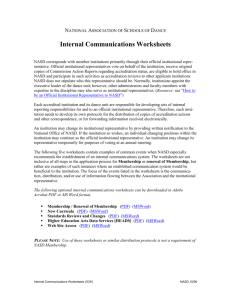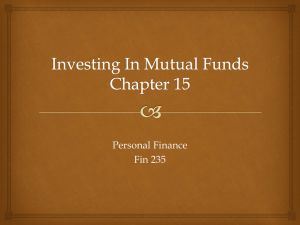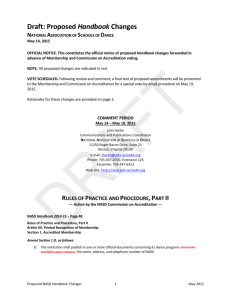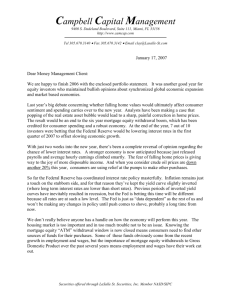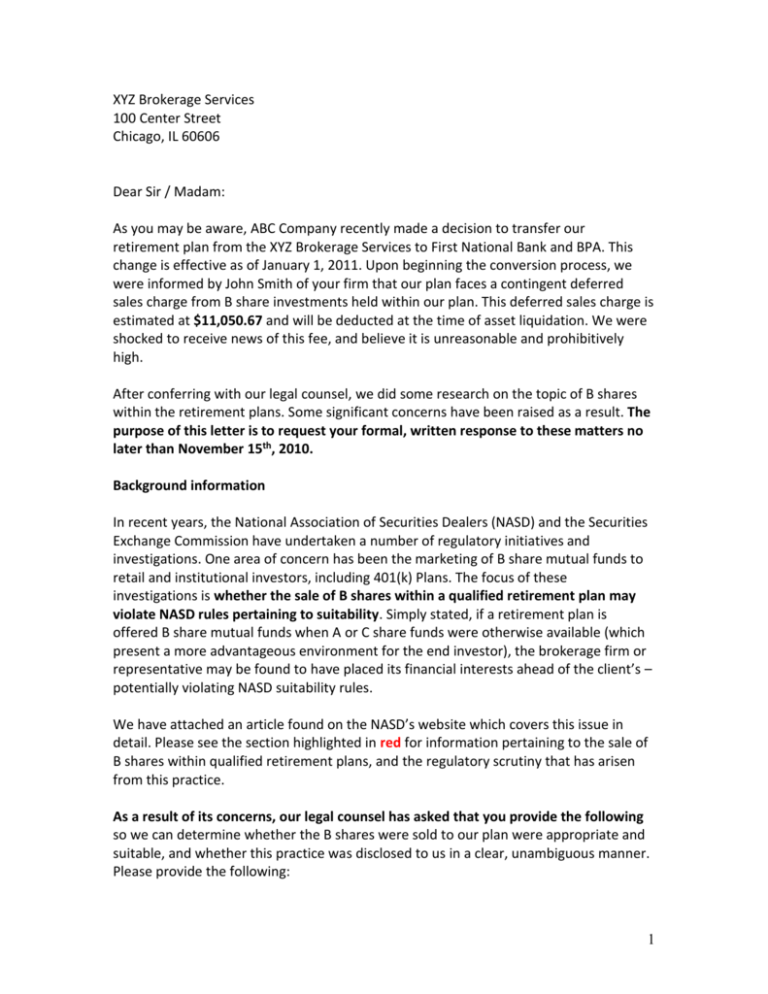
XYZ Brokerage Services
100 Center Street
Chicago, IL 60606
Dear Sir / Madam:
As you may be aware, ABC Company recently made a decision to transfer our
retirement plan from the XYZ Brokerage Services to First National Bank and BPA. This
change is effective as of January 1, 2011. Upon beginning the conversion process, we
were informed by John Smith of your firm that our plan faces a contingent deferred
sales charge from B share investments held within our plan. This deferred sales charge is
estimated at $11,050.67 and will be deducted at the time of asset liquidation. We were
shocked to receive news of this fee, and believe it is unreasonable and prohibitively
high.
After conferring with our legal counsel, we did some research on the topic of B shares
within the retirement plans. Some significant concerns have been raised as a result. The
purpose of this letter is to request your formal, written response to these matters no
later than November 15th, 2010.
Background information
In recent years, the National Association of Securities Dealers (NASD) and the Securities
Exchange Commission have undertaken a number of regulatory initiatives and
investigations. One area of concern has been the marketing of B share mutual funds to
retail and institutional investors, including 401(k) Plans. The focus of these
investigations is whether the sale of B shares within a qualified retirement plan may
violate NASD rules pertaining to suitability. Simply stated, if a retirement plan is
offered B share mutual funds when A or C share funds were otherwise available (which
present a more advantageous environment for the end investor), the brokerage firm or
representative may be found to have placed its financial interests ahead of the client’s –
potentially violating NASD suitability rules.
We have attached an article found on the NASD’s website which covers this issue in
detail. Please see the section highlighted in red for information pertaining to the sale of
B shares within qualified retirement plans, and the regulatory scrutiny that has arisen
from this practice.
As a result of its concerns, our legal counsel has asked that you provide the following
so we can determine whether the B shares were sold to our plan were appropriate and
suitable, and whether this practice was disclosed to us in a clear, unambiguous manner.
Please provide the following:
1
1. Supporting documentation that the B share investments were clearly explained
to us as Plan Sponsor, including the differences between B shares and A, C, R or
other share classes that you make available to other plan sponsor clients. Also, a
summary of the exit penalties or restrictions applicable to various share classes
and how this was explained and disclosed to us.
2. Evidence that we, as plan sponsor affirmatively elected to utilize the B share
investments within our plan, including a signed instrument with the name and
person from our firm who provided this written authorization.
3. Evidence that the B share funds were fully explained to plan participants,
including the CDSC fees that may be applicable for participant-initiated transfers
or a plan-wide move away from your firm.
4. A written statement that was made to participants that if certain fund(s) were
chosen, CDSC penalties could apply if their employer chose to change service
providers later (an event entirely outside of the participant’s control).
5. A summary of any costs incurred by your firm in acquiring our business (including
compensation paid to brokers, agents or other firms or individuals) and what
level of annual revenue was included in our fee schedule in order to recoup such
costs over the life of our relationship.
6. Any other material or information that would support that the sale of B shares to
our plan was suitable, reasonable and fully disclosed.
Please send this information directly to me at the address shown below via overnight or
certified mail no later than November 15th, 2010. After our counsel reviews the
information, we will be in touch to set up a conference call to discuss the matter with
your legal counsel. If it is not clear from reading this letter, our goal is to have the CDSC
penalties waived so our plan can transition to the new provider without the adverse
penalty, since we feel that we were not properly informed of the ramifications of using
B shares, and their sale to our plan may have been a violation of the NASD suitability
provisions.
Again, our interest is in having this matter resolved. However, please be aware that if
we fail to have this matter adequately resolved in way that is fair and consistent with
the spirit of ERISA, we reserve the right to refer this matter to the National Association
of Securities Dealers or the Securities and Exchange Commission for further review.
I may be reached at 312-888-0000 with any questions.
Best regards,
2
Jane R. Smith
Vice President/Human Resource Manager
ABC Company, Inc.
100 Main Street
Anytown, NY 10101
Article from NASD.com
From http://www.nasd.com/media/speeches/glauber_2003_06.asp
Testimony of Robert R. Glauber
NASD Chairman and CEO
Before the Senate Committee on Banking, Housing, and Urban Affairs
Hearing to Review Current Investigations and Regulatory Actions
Regarding the Mutual Fund Industry
United States Senate
November 20, 2003
Mr. Chairman and Members of the Committee: NASD would like to thank the committee
for the invitation to submit this written statement for the record.
NASD
NASD, the world’s largest securities self-regulatory organization, was established in
1939 under authority granted by the 1938 Maloney Act Amendments to the Securities
Exchange Act of 1934. Every broker/dealer in the U.S. that conducts a securities
business with the public is required by law to be a member of NASD. NASD’s jurisdiction
covers nearly 5,400 securities firms that operate more than 92,000 branch offices and
employ more than 665,000 registered securities representatives.
NASD writes rules that govern the behavior of securities firms, examines those firms for
compliance with NASD rules, MSRB rules, and the federal securities laws, and disciplines
those who fail to comply. Last year, for example, we filed a record number of new
enforcement actions (1,271) and barred or suspended more individuals from the
securities industry than ever before (814). Our investor protection and market integrity
responsibilities include examination, rulewriting and interpretation, professional
training, licensing and registration, investigation and enforcement, dispute resolution,
and investor education. We monitor all trading on the NASDAQ Stock Market—more
than 70 million orders, quotes, and trades per day. NASD has a nationwide staff of more
than 2,000 and is governed by a Board of Governors at least half of whom are
unaffiliated with the securities industry.
NASD’s involvement with mutual funds is predicated on our authority to regulate
broker/dealers. NASD does not have any jurisdiction over investment companies or the
3
fund’s investment adviser; rather, we regulate the sales practices of broker/dealers who
sell the funds to investors. Our investor education efforts also place special emphasis on
mutual funds due to their widespread popularity with investors.
The behavior that has been uncovered in the mutual fund industry has been
reprehensible. The mutual fund industry was for years an example of a clean, disciplined
industry. This reputation help fostered growth in these products that offered investors
relatively low cost professional management, diversification, and risk control to fit a
wide range of investor needs. But now the industry has seriously undermined investor
trust with a wide range of abuses—portfolio managers trading ahead of mutual fund
investors, differential release of portfolio information, deals with preferred customers
to permit market timing trades. Broker participation in illegal or unethical sales practices
is very much a direct concern of NASD.
Disclosure
This week during testimony before this Committee, Securities and Exchange
Commission (SEC) Chairman Donaldson discussed a series of reforms in the realm of
disclosure that he intends to seek. NASD supports these SEC efforts. Investors deserve
clear and easy-to-read disclosure that tells them of all the costs associated with their
mutual funds. Not just the load and fees that affect investor costs but also the other
arrangements that affect the price—including commission expenses and compensation
arrangements between the broker and the fund. One of the bedrock principles of our
free market system is that all participants have access to information about prices and
costs that can influence their decisions. When this information is hidden or distorted,
buyers are not able to make the best decisions about where to invest their money.
In August, NASD proposed greatly expanded disclosure of mutual fund compensation
arrangements. The proposal is designed to alert investors to the financial incentives that
a brokerage firm or its registered representatives may have to recommend particular
funds.
The proposal would ensure that investors receive timely information about two types of
compensation arrangements. The first consists of cash payments by fund sponsors to
broker/dealers to induce fund sales. Typically, these payments are made in order to gain
"shelf space" at the broker, or to secure a place for a fund on a preferred sales list. The
second is the payment by a broker/dealer of a higher compensation rate to its own
registered representatives for selling certain funds. The proposal would require firms to
disclose these compensation arrangements in writing when the customer first opens an
account or purchases mutual fund shares. The proposal also would require member
firms to update this information twice a year and make it available on their Web sites,
through a toll-free number, or in writing.
4
The comment period on the proposal ended October 17, 2003. NASD has received
approximately 40 comment letters on the proposal, which the staff is reviewing.
Recent Enforcement Efforts and Rule 2830
To combat abuses in the realm of our regulatory authority, we have concentrated our
examination and enforcement focus on five main areas: first, cash and non-cash
compensation practices and arrangements; second, the suitability of the mutual funds
that brokers are selling, in particular B share abuses; third, whether brokers are
delivering to their customers the benefits to which they are entitled, such as breakpoint
discounts; and finally, market timing and late trading. All told, we have brought some 60
enforcement cases this year in the mutual fund area, and more than 200 over the last
three years. We also have a large number of ongoing examinations and investigations
involving these and other mutual fund issues.
Cash and Non-Cash Compensation Practices and Arrangements
Just this week, NASD announced an enforcement action against Morgan Stanley for
giving preferential treatment to certain mutual fund companies in return for millions of
dollars in brokerage commissions. This is the second action brought by NASD against
Morgan Stanley for mutual fund violations in the last two months and is part of our
broader effort to crack down on sales practice abuses. In conjunction with a related
action filed by the SEC, Morgan Stanley agreed to resolve the NASD and SEC actions by
paying $50 million in civil penalties and surrendered profits, all of which will be returned
to injured investors.
In the Morgan Stanley case, NASD found that from January 2000 until 2003, Morgan
Stanley operated two programs which gave favorable treatment to products offered by
as many as 16 mutual fund companies out of a total of over 115 fund complexes that
could be sold by the firm's sales force. In return for these brokerage commissions and
other payments, mutual fund companies received preferential treatment by Morgan
Stanley, which included:
Placement on a "preferred list" of funds that financial advisors were to look to first in
making recommendations of fund products;
Higher visibility on Morgan Stanley's sales systems and workstations than non-paying
funds;
Eligibility to participate in the firm's 401(k) programs and to offer offshore fund
products to Morgan Stanley customers;
Better access to its sales force and branch managers; and
Payment of special sales incentives to Morgan Stanley financial advisors.
5
In addition, the participating mutual fund companies paid Morgan Stanley an extra 15 to
20 basis points on each sale. This was over and above the normal fees earned by the
firm for selling the funds.
This extra compensation paid to Morgan Stanley for the preferential treatment included
millions of dollars paid by the mutual funds through commissions charged by the firm
for trades it executed for the funds. These commissions were sufficiently large to pay for
the special treatment, as well as the costs of trade execution. This conduct violated
NASD's Conduct Rule 2830(k), one important purpose of which is to help eliminate
conflicts of interest in the sale of mutual funds.
NASD is also conducting an examination sweep where we are looking at more than a
dozen broker/dealers, specifically with a view to determine how investment companies
pay for inclusion on firms’ featured mutual fund lists or why they receive favored
promotional or selling efforts. Thousands of funds are presented to investors through
discount and online broker/dealer "supermarkets." We are looking at different types of
firms, including full-service, discount, and online broker/dealers. In addition, we are
examining a similar number of mutual fund distributors, who are also our members.
Mutual fund sponsors and distributors that once marketed exclusively through a single,
traditional distribution channel often now compete head-to-head in the same
distribution channels vying for visibility and valuable "shelf space." We want to see what
the distributors’ role may be in these types of practices.
As demonstrated in the recent case against Morgan Stanley, exchanging prominent
placement of a fund or family of funds on a firm’s Web site or in the firm’s marketing
material or placing a fund on a "featured" or "preferred" list of funds in exchange for
brokerage commissions from the funds constitutes a violation of NASD rules.
Another section of NASD Conduct Rule 2830 prohibits the award of non-cash
compensation, such as lavish trips and entertainment, to brokers for the sale of mutual
fund shares. In September, we brought another case against Morgan Stanley that
resulted in a $2 million fine against the firm. Morgan Stanley conducted prohibited sales
contests for its brokers and managers to push the sale of Morgan Stanley's own
proprietary mutual funds. In addition to censuring and fining the firm, NASD also
censured and fined a senior member of the firm’s management—the head of retail
sales.
Between October 1999 and December 2002, the firm had conducted 29 contests and
offered or awarded various forms of non-cash compensation to the winners, including
tickets to Britney Spears and Rolling Stones concerts, tickets to the NBA finals, tuition
for a high-performance automobile racing school, and trips to resorts.
The obvious danger of such contests is that they give firm personnel a powerful
incentive to recommend products that serve the broker's interest in receiving valuable
6
prizes, rather than the investment needs of the customer. And one of the most
troubling things about this case is Morgan Stanley's failure to have any systems or
procedures in place that could detect or deter the misconduct.
In January 2003, NASD censured and fined IF Distributor, Inc., and VESTAX Securities
Corp. a total of $150,000 for failing to disclose special cash compensation they paid to
their sales force in the sale of mutual fund shares. Prior to disclosing this special cash
compensation, the brokers sold over $20 million in Class A shares to over 200
customers. Brokers selling these shares received approximately $220,000 in special cash
compensation.
Suitability of Mutual Fund Sales—Class B Shares
Many mutual funds offer different classes of the same investment portfolio. Each class
is designed to provide brokers and their customers with a choice of fee structure. Class
A mutual fund shares charge a sales load when the customer purchases shares. Class B
shares do not impose such a sales charge. Instead, Class B shares typically impose
higher expenses that investors are assessed over the lifetime of their investment.
Class B shares also normally impose a contingent deferred sales charge (CDSC), which
a customer pays if the customer sells the shares within a certain number of years. In
addition, investors who purchase Class B shares cannot take advantage of breakpoint
discounts available on large purchases of Class A shares.
NASD has found that some brokers have unscrupulously recommended Class B shares
in such large amounts that the customer would have qualified for breakpoint
discounts had the broker recommended Class A shares instead. In this instance, the
broker may receive higher compensation for the Class B recommendations. NASD has
vigorously prosecuted these violations, and we are continuing a comprehensive
review of Class B shares sales practices. Over the last two years, NASD has brought
more than a dozen enforcement actions against firms and individual brokers for these
types of violations. Presently, we have more than 50 open and active investigations in
this area.
For example, in May the SEC affirmed a disciplinary action NASD took against Wendell
D. Belden, who was found to have violated NASD's suitability rule by recommending
that a customer purchase Class B mutual fund shares in five different mutual funds
within two fund families instead of Class A mutual fund shares. Because of the size of
his customer's investment ($2.1 million) and the availability of breakpoint discounts
for Class A shares, Belden's recommendations caused his customer to incur higher
costs, including contingent deferred sales charges.
Belden tried to justify his recommendations to customers that they purchase the Class
B shares instead of the Class A shares because he received greater commissions on the
sales of these shares. He stated that he "couldn't stay in business" with lower
7
commissions. Belden was fined, suspended, and ordered to pay more than $50,000
back to his customers.
In June we announced a settled action against McLaughlin, Piven, Vogel for violations
in this area. The firm was fined $100,000 and ordered to pay restitution of
approximately $90,000 to 21 customers. In August we announced five more actions
for unsuitable sales of Class B shares.
Breakpoint Discounts
Mutual funds typically offer discounts to the front-end sales load assessed on Class A
shares at certain predetermined levels of investment, which are called "breakpoints."
The extent of the discount is based on the dollar size of the investor’s investment in the
mutual fund. For example, breakpoint discounts may begin at dollar levels of $25,000
(although, more typically, at $50,000) and increase at $100,000, $250,000, $500,000,
and $1,000,000. At each higher level of investment, the discount increases, until the
sales charge is eliminated.
An investor can become entitled to a breakpoint discount to the front-end sales charge
in a number of ways. First, an investor is entitled to a breakpoint discount if his single
purchase is equal to or exceeds the specified "breakpoint" threshold. Second, mutual
funds generally allow investors to count future purchases toward achieving a breakpoint
if the investor executes a letter of intent that obligates him to purchase a specified
amount of fund shares in the same fund or fund family within a defined period of time.
Similarly, mutual funds generally grant investors "rights of accumulation," which allow
investors to aggregate their own prior purchases and the holdings of certain related
parties toward achieving the breakpoint investment thresholds (including reaching
investment thresholds necessary to satisfy letters of intent).
Mutual fund families began to offer these breakpoint discounts to make their funds
more attractive to investors. Over time, funds expanded the rights of accumulation they
offered by expanding the categories of accounts that could be linked or aggregated for
the purpose of obtaining breakpoint discounts. Mutual funds view their aggregation
rules as important competitive features of their products. Accordingly, these rights of
accumulation can vary from fund family to fund family, and many fund families define
the related parties that can aggregate their holdings to determine breakpoint discount
eligibility differently. For instance, one fund family may allow parents to link their
accounts with a "minor child," while another fund family may allow parents to link their
accounts with any child residing at home.
During routine examinations of broker/dealers by our Philadelphia District Office, NASD
discovered that broker/dealers selling front-end load mutual funds were not properly
delivering breakpoint discounts to investors. Following this discovery, in November and
December 2002, the SEC and New York Stock Exchange joined us for an examination
8
sweep of 43 firms selling front-end load mutual funds. We found that most of those
firms did not give investors all the breakpoint discounts they should. Failures to give the
discounts stemmed from a variety of different operational problems, including a failure
to link share classes and holdings in other funds in the same fund family and a failure to
link accounts of family members.
NASD issued a Notice to Members on December 23, 2002, reminding firms to explain
and deliver breakpoints. And, we issued in January 2003 an Investor Alert to advise
customers of breakpoint opportunities.
Also in January 2003, the SEC asked NASD to lead a task force to find breakpoint
solutions. The task force had 24 members, including representatives from
broker/dealers, mutual funds, transfer agents, clearing facilities, academia, the SEC
staff, other SRO’s, and trade associations.
The Task Force issued its report in July 2003, in which it recommended a number of
technological and operational changes, as well as modifications to mutual fund
prospectus and other disclosure and sales practices, to ensure that customers are not
overcharged. Working groups, consisting of knowledgeable representatives of the
mutual fund and securities industries, are currently engaged in implementation of the
Task Force recommendations. NASD and the SEC receive periodic reports from these
Working Groups and are monitoring progress as implementation moves forward.
As for the transactions that should have received discounts, NASD supplemented its
referenced examination effort with a survey of every NASD member to learn more
about each member's overall mutual fund activities. The survey, in turn, provided NASD
with information that helped us frame a self-assessment. Specifically, NASD directed
firms to perform an assessment of their own of breakpoint discounts delivery. These
self-assessments were carried out through use of a carefully constructed sample of
transactions, which permitted NASD to extrapolate each firm’s performance to its entire
universe of transactions. NASD has concluded that, during the 2001 to 2002 period
covered by the self-assessments, investors were overcharged in about one out of every
five transactions in which they were eligible for breakpoint discounts. Those
overcharges, in our view, total at least $86 million, and the average overcharge was
$243. When the assessments were complete, firms were directed to refund overcharges
to investors, with interest. In addition, NASD will require that most of the firms involved
undertake further action, including contacting their customers individually to alert them
to possible overcharges. Disciplinary or enforcement proceedings will be brought
against certain of the firms.
Late Trading and Market Timing
Investment Company Act Rule 22(c)(1) generally requires that mutual fund shares be
sold and redeemed at a price based on the net asset value (NAV) of the fund computed
9
after the receipt of the order. In practice this requirement means that mutual fund
shares are priced according to the value of their securities portfolio, computed at the
next close of the national securities exchanges. For example, if a mutual fund receives
an order to purchase shares before the close of the securities exchanges, 4 p.m., EST,
the investor should receive a price based on that 4 p.m. close. If, however, a mutual
fund receives an order to purchase shares after the 4 p.m. close, the investor should
receive a price based on the next day’s 4 p.m. close. This "forward pricing" requirement
represents a fundamental principle of the Investment Company Act, for it prevents
investors who might have access to the NAV of the portfolio from trading on that
information.
The failure to meet the forward pricing standard has become known as "late trading."
Late trading, however, should be distinguished from the practice, followed by many
broker/dealers and other intermediaries, of transmitting orders after 4 p.m. because
they require additional processing time. For example, some intermediaries may net out
transactions by pension plan participants in order to simplify their order to the mutual
fund company. In these instances, the participants entered their orders before 4 p.m.,
but the orders of the plan were not processed and transmitted until after 4 p.m.
The frequent trading of mutual fund shares in order to take advantage of pricing
inefficiencies or market movements has become known as "market timing." Market
timing is not per se illegal. Market timing activities become illegal when they violate the
fiduciary duty of the fund’s investment adviser; they also are problematic when they
violate a stated policy of the fund as disclosed in the fund’s prospectus. Many mutual
funds police market timing by their shareholders, because market timing can increase
fund expenses and harm fund performance for the other shareholders. When a mutual
fund has disclosed a policy of protecting investors from market timers, a broker/dealer
may not knowingly or recklessly collude with the fund in order to effect a market timing
transaction. Broker/dealers must have in place policies and procedures reasonably
designed to detect and prevent this collusion.
In response to prevailing issues concerning mutual fund execution, in September NASD
sought information from roughly 160 firms regarding late trading and impermissible
market timing.
As a preliminary matter, we have determined that numerous firms’ conduct warranted a
referral to NASD’s Enforcement Department for further investigation and possible
disciplinary action. Another group of firms is being examined by our Member Regulation
Department for potential late trading and impermissible market timing misconduct.
Specifically, a number of firms disclosed that they had, or probably had, received and
entered mutual fund orders after U.S. markets closed for the day. Some of these firms
disclosed specifically that they had accepted and entered late trades; other firms
disclosed that they "probably" accepted and entered late trades. This imprecision in the
10
latter group indicates separate issues of poor internal controls and record keeping.
These matters, too, have been referred to NASD’s Enforcement Department for action.
NASD also has identified a number of firms that were involved in market timing and it
remains to be determined whether their activities were impermissible under our rules
or applicable statutes. These firms appear to have facilitated a customer’s market timing
strategy in mutual funds or variable annuities, had employees who agreed with a mutual
fund or variable annuity to market time the issuer’s shares, or had an affiliate involved
in some form of market timing of mutual funds or variable annuities. We are
investigating any broker/dealer that made any of these disclosures in our investigations.
We will investigate whether these firms simply allowed market timing, which is not per
se illegal, or whether they colluded with the mutual fund companies to evade the fund’s
stated policies against market timing.
Investor Education
Mutual funds have been a particular focus of NASD's investor education efforts. This
year alone, we have issued Investor Alerts on:
Mutual fund share classes
Mutual fund breakpoints
Principal-protected funds
Class B mutual fund shares
Each of these Investor Alerts educates investors about the wide variety of mutual fund
fee structures that exist and urges investors to scrutinize mutual fund sales charges,
fees, and expenses.
Research has shown that many investors are unaware of how much they pay to own
mutual funds and that even small differences in fees can result in thousands of dollars of
costs over time that could have been avoided. To help investors make better decisions
when purchasing mutual funds, we have unveiled an innovative "Mutual Fund Expense
Analyzer" on our Web Site. Unlike other such tools, the Expense Analyzer allows
investors to compare the expenses of two funds or classes of funds at one time, tells the
investor how the fees of a particular fund compare to industry averages, and highlights
when investors should look for breakpoint discounts. To make this tool more widely
available to investors, we are developing a version of the Expense Analyzer for
broker/dealer Web sites.
Conclusion
NASD will continue its vigorous examination and enforcement focus on the suitability of
the mutual fund share classes that brokers are selling, the compensation practices
between the funds and brokers, and the question of whether brokers are delivering to
11
their customers the benefits offered to them, such as breakpoint discounts. And as we
continue our examinations and investigations into late trading and market timing issues,
we will enforce NASD rules with a full range of disciplinary options—which include stiff
fines, restitution to customers, and the potential for suspension or expulsion from the
industry. While NASD cannot alone solve all the problems revealed in recent months in
the mutual fund industry, we have jurisdiction over all broker/dealers that sell these
products to investors and will rigorously exercise our authority to take actions against
violators as part of our overall efforts to protect investors and to restore investor
confidence.
| Top |
© 2004 NASD, Inc. All rights reserved. | NASD is a registered trademark of NASD Inc. |
Legal Notices and Privacy Policy.
12



